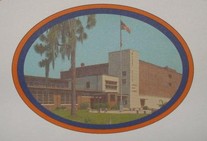
Plant City High School

Plant City:Its Origin and History
by Quintilla Geer Bruton and David E Bailey, Jr. - Copyright 1984
From page 279:
A new Marshall High School was built in 1957 on a thirty-acre tract on Maryland Avenue, a few blocks north of the old school. Both junior and senior high classes were transferred to the new school. Lincoln Elementary, formerly Midway Academy, was then able to take back its fifth and sixth grade students who, due to over-crowding, had been sent across town to the new Simmons Elementary School when it was built in 1951.
Hillsborough County began desegregation of schools after much discussion and planning by members of both races. Faculties were integrated at all levels in the fall of 1969, and integration of the student body began with the 1971 school term. An attempt was made to have in each school the same percentage of each race as existed in the general population.
The two former black elementary schools were converted to sixth grade centers, attended by students of both races, and Marshall became a seventh grade enter. Students were transported by bus to the three centers.
Desegregation went more smoothly in Hillsborough County than in other places which experienced almost daily disruptions and some violence. Reporter John Perry, writing on integration of county schools, gave particular credit for this to "a calm, tough and imaginative veteran school administratior, E.L. Bing, a black man then in his fifties." Mr. Bing was born in Plant City and attended Lincoln School. He was principal of Marshall from June, 1954 until 1967, when he was made Director of Federal Projects.
According to Mr. Perry's report, Mr. Bing sent one hundred and fifty-six invitations to county leaders and just plain representative citizens of both races. He made a point to include some known to be strongly opposed to integration. A surprising two-thirds of those invited to participate accepted, including General Paul D Adams, Retired, who had headed the U.S. Strike Commad at MacDill Air Force Base. He agreed to serve as chairman of the Citizens Committee.
Agreeing to serve as charimen of important subcommittees were: Frank Moody, a member of an influential Plant City family and chairman of the board and president of the Hillsboro Bank; Edward D. Davis, a leading black businessman and president of Central Life Insurance Company, and Mrs. Adrian Sundheim, a leader in the Parent-Teachers' Association. The latter two were Tampa residents.
Mr. Bing and members of his committees realized that for a plan to work it had to do more than meet court requirements. It would have to be educationally sound, financially feasible, cause as little disruption as possible, and be fair to all segments of the population. The results of their dedicated work was a plan that became a forerunner for the nation.




